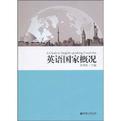英语国家概况
2009-9
华东理工大学出版社
张明爱 编
250
本书全面叙述了英国、美国、加拿大、澳大利亚、新西兰五个主要英语国家的地理、历史、政治、文化、教育、宗教等社会生活各方面的情况,图文并茂,内容丰富多彩,语言流畅易懂,编排简洁清新,主要内容附中文概要。 本书资料来源于英美等国家官方发布的最新数据,信息准确,内容新颖,是主要英语国家社会各领域发展的最新体现。 本书作者系各高校英语专业从事英语国家国情教学和研究多年的资深学者,他们大多都有国外工作生活经历,对于英语国家国情的了解与把握透彻而理性。除主要作者外,曹磊、沈群、杨春春、韩娜老师都参加了本书部分内容的编写工作。外籍专家StanleyRoy教授和MichaelRadice博士对本书内容作了全面审读和修正,在此向他们表示诚挚的感谢。 本书可供全国高等院校英语专业学生作为英语国家概况课程的教材使用。同时,本书可作为研究英语国家国情的学者、对英语国家国情感兴趣的读者和出国留学生了解和研究英语国家国情的参考书使用。
《英语国家概况》全面而系统地叙述了英国、美国、加拿大、澳大利亚和新西兰五个主要英语国家的地理、历史、政治、文化、教育等诸多方面,图文并茂,内容丰富,语言流畅易懂,编排简洁清新。全书主要内容均附有中文概要,以备读者参照使用。 该书可供全国高等院校英语专业学生作为英语国家概况课程的教材使用,也可供研究英语国家国情的学者、对英语国家国情感兴趣的读者和准备出国留学的学生参考使用。
Part 1 The United KingdomChapter 1 A General ViewⅠ Climate of the UKⅡ EnglandⅢ ScotlandⅣ WalesⅤ Northern IrelandⅥ The Commonwealth of NationsChapter 2 Early British HistoryⅠ Early SettlersⅡ Roman BritainⅢ The Anglo-Saxons (446-871)Ⅳ The Norman Conquest (1066)Ⅴ Norman Rule (1066-1381)Ⅵ The Great Charter and the Beginning of the ParliamentⅦ The Hundred Years War with France (1337-1453)Ⅷ The Black Death (1348-1349)Ⅸ The War of the Roses (1455-1485)Ⅹ The English ReformationⅪ James I (1603-1625) and the ParliamentⅫ Charles I (1625-1649) and English Civil War* The Restoration* The Glorious Revolution of 1688Chapter 3 The Industrial Revolution (1780-1830)Chapter 4 Colonial ExpansionⅠ The Seven Years WarⅡ The Growth of DominionsⅢ The Conquest of IndiaⅣ The Colonization in South AfricaⅤ Aggression Against ChinaⅥ Britain and the First World War (1914-1918)Ⅶ Britain and the Second World WarⅧ Decolonization and Decline (1945-1997)Chapter 5 The Government of the United KingdomⅠ The MonarchyⅡ The ParliamentⅢ The Cabinet and Privy CouncilⅣ The ConstitutionⅤ Government DepartmentsⅥ British Political PartiesChapter 6 CultureⅠ Primary EducationⅡ Secondary EducationⅢ Higher EducationⅣ Festivals and Public HolidaysⅤ Religion in BritainⅥ British LiteraturePart 2 The United States of AmericaChapter 1 A General SurveyⅠ Location and SizeⅡ GeographyⅢ ClimateⅣ American Geographical RegionsChapter 2 HistoryⅠ The Colonization of the New WorldⅡ The War of IndependenceⅣ The War of 1812Ⅳ Territorial Expansion and Westward MovementⅤ The Civil WarⅥ World War Ⅰ and the United StatesWorld War Ⅱ and the United StatesChapter 3 The Government of USAⅠ Legislative BranchⅡ PresidentⅢ Judicial BranchⅣ Elections and VotingⅤ Cold War and Civil RightsⅥ Political PartiesChapter 4 American CultureⅠ Race & EthnicityⅡ ReligionⅢ EducationⅣ HolidaysⅤ LiteraturePart 3 CanadsChapter 1 A General ViewⅠ GeographyⅡ Provinces and TerritoriesⅢ ClimateⅣ DemographicsChapter 2 The History of CanadaChapter 3 The Government of CanadaChapter 4 Canadian CultureⅠ EducationⅡ religionⅢ Festivals and HolidaysPart 4 AustraliaChapter 1 A General SurveyⅠ GeographyⅡ Political RegionsⅢ ClimateⅣ DemographyChapter 2 Australian HistoryChapter 3 The Government of AustraliaChapter 4 Australian CultureⅠ EducationⅡ ReligionⅢ Festivals and HolidaysChapter 5 Plants and AnimalsPart 5 New ZeslandChapter 1 A General SurveyⅠ GeographyⅡ ClimateChapter 2 HistoryChapter 3 The Government of New zealandChapter 4 CultureⅠ EducationⅡ ReligionⅢ Festivals and HolidaysChapter 5 Plants and Animals附录中文概要第一部分 英国一、概况二、历史三、政府四、文化第二部分 美国一、概况二、历史三、政府四、文化第三部分 加拿大第四部分 澳大利亚第五部分 新西兰参考文献
Charles wished to move the Church of England away from Calvinism in a moretraditional and sacramental direction. This goal was shared by his main politicaladviser, Archbishop William Laud. Laud was appointed by Charles as the Archbishopof Canterbury in 1633, and started a series of unpopular reforms in an attempt toimpose order and authority on the church. Laud attempted to ensure religious uniformity by dismissing non-conformistclergymen and closing Puritan organizations. This was actively hostile to the reformedtendencies of many of his English and Scottish subjects. His policy was obnoxious toCalvinist theology. Laud was also an advocate of Arminian theology, which wasviewed as heretical and virtually "Catholic" by strict Calvinists. When Charles attempted to impose his religious policies in Scotland he facednumerous difficulties. The King ordered the use of a new prayer book modelled on theEnglish Book of Common Prayer, which, although supported by the Scottish Bishops,was resisted by many Presbyterian Scots, who saw the new prayer book as a vehicle forintroducing Anglicanism to Scotland. When the General Assembly of the Church ofScotland abolished Episcopalian government (governance of the Church by bishops) in1638, replacing it with Presbyterian government (governance by elders and deacons),Charles sought to put down what he saw as a rebellion against his authority. In 1639, when the First Bishops War broke out, Charles sought to collect taxesfrom his subjects, who refused to yield any further. Charless war ended in ahumiliating truce in June of the same year. In the Pacification of Berwick, Charlesagreed to grant his Scottish subjects civil and ecclesiastical freedoms. Charless militaryfailure in the First Bishops War in turn caused a financial and military crisis for him.
